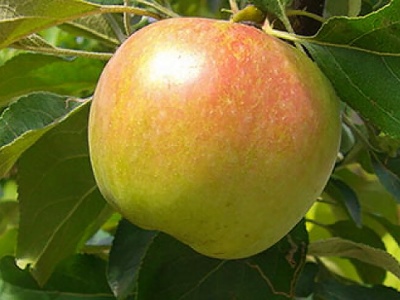
- Authors: Leningrad Fruit and Vegetable Experimental Station (LPOOS)
- Taste: pleasant, dessert
- Scent: gentle, light
- Fruit weight, g: from 120
- Yield: up to 200 kg per tree
- The beginning of fruiting varieties: for 4-5 years
- Ripening terms: autumn
- Removable maturity: beginning of September
- Keeping quality: about 2 months
- Appointment: universal
When choosing a crop for planting on his site or in the garden, each gardener tries to find a variety that will be adapted to the characteristics of a particular climate. So, in the north-west of the Russian Federation, among apple varieties, one of the first places is occupied by Baltika.
Breeding history of the variety
Work on the Baltika variety began in the middle of the 20th century. We were engaged in this at the Federal State Budgetary Scientific Institution - the Institute of Agroengineering and Environmental Problems of Agriculture (formerly the Leningrad Fruit and Vegetable Experimental Station - LPOOS). The main goal set for itself by a group of breeders, consisting of Lavrikov and Zhmurko, is adaptability to the rather often changeable weather conditions of the Baltic coast, Leningrad region, as well as the Moscow region. Scientists sought to obtain a culture that is hardy for any growing conditions.
The main progenitor was the Borovinka apple tree - an old Russian varietal variety. By its free pollination with different winter apple crops, the Baltika apple tree was obtained. Throughout the 1960s, field trials of the hybrid continued, which were carried out on the basis of different farms. The hybrid performed very well. The application for release and inclusion in the State Register of the variety was filed in the 90s. They received approval only in 2002. At the same time, the apple tree was ranked among the elite varieties and zoned for all declared regions.
Description of the variety
Apple-tree Baltica is vigorous, in height it can reach 5-5.5 meters. A young tree is distinguished by a pyramidal crown, however, closer to the fruiting period, it becomes more rounded, even oval.
The plant has fairly strong skeletal branches, medium thickening. Erect shoots, not thick. The bark has a brownish brown tone, with slight pubescence. The foliage is large, broadly ovate, with a wavy edge, light green in color. The leaf blade is slightly concave, has a smooth shiny surface, with reticular veins. The petiole is of medium thickness. There are no stipules.
The Baltika variety is distinguished by its white flowers, which bloom on the 20th of May. Consequently, there can no longer be recurrent frosts that would beat the plant.
Features, pros and cons
Baltika is a variety of apple trees with many advantages:
- good early maturity;
- high yield;
- regular and annual fruiting;
- very high winter hardiness;
- persistent immunity to infections such as fungus and scab;
- transportation is easy, the commercial qualities are preserved;
- keeping quality - up to 2 months;
- the versatility of the fruit is an excellent dessert, as well as processing into juices, jam, preserves.
Of the shortcomings, the apple tree is not self-fertile, it is required to plant pollinator varieties nearby, among which the most suitable are Antonovka, Osennee Polosatoe and Melba.
Ripening and fruiting
The Baltic belongs to the autumn ripening period. Removable maturity is observed in the first autumn days. The apple tree is one of the early-growing ones, already in 4-5 years the Baltic will bring a stable harvest.
Growing regions
The regions of growth of the Baltic apple tree are a number of northern regions, in the middle lane, as well as the south of Russia.
Yield
Apple-tree Baltika is a fairly productive variety. During the season, 170 to 200 kg of apples are harvested from one tree. The average long-term yield of this variety in the region is 187 centners per hectare.
Fruits and their taste
The apples of the Baltika variety cannot be called very large, but each can weigh from 120 to 140 grams. The fruits are either turn-shaped or round, with a smooth surface, on which there are no clearly defined ribs. The skin of the fruit is dense, the color of the apple is light yellow. There is a cover pink blush on the surface. Slight waxy coating.
The flesh of the fruit is white, juicy and firm. The taste is sweet and sour, with a light pleasant aroma. The tasting score on a five-point scale is 4.5. Composition of 100 grams of fruit pulp:
- sugar - 8-10%;
- titratable acidity - 0.3-0.9%;
- ascorbic acid - up to 10.4 mg.

Growing features
It is better to carry out activities for planting an apple tree Baltica in the fall, a few weeks (2-3) before frost. If you are late with planting, you can save the seedlings until spring. To do this, make a groove half a meter deep, lay a tree in it at an angle of 45 degrees, so that its upper part looks south. Roots, part of the trunk must be covered with soil and watered. The roots must be underground all this time.
In general, the care of the variety is standard. It includes watering, feeding, loosening the trunk circle, preventive treatments against diseases and insect pests. Pruning is done in the spring. With its help, the crown is relieved of thickening, which is unnecessary. The apple tree propagates both by grafting and by cuttings and layering.






The apple tree is a popular fruit crop among gardeners. It can be found in many summer cottages. But at the same time, such trees are often affected by various diseases. It is very important to recognize the disease in time and carry out the necessary procedures for a speedy recovery.Otherwise, the fruits will be spoiled, and the tree itself may die altogether.












































































